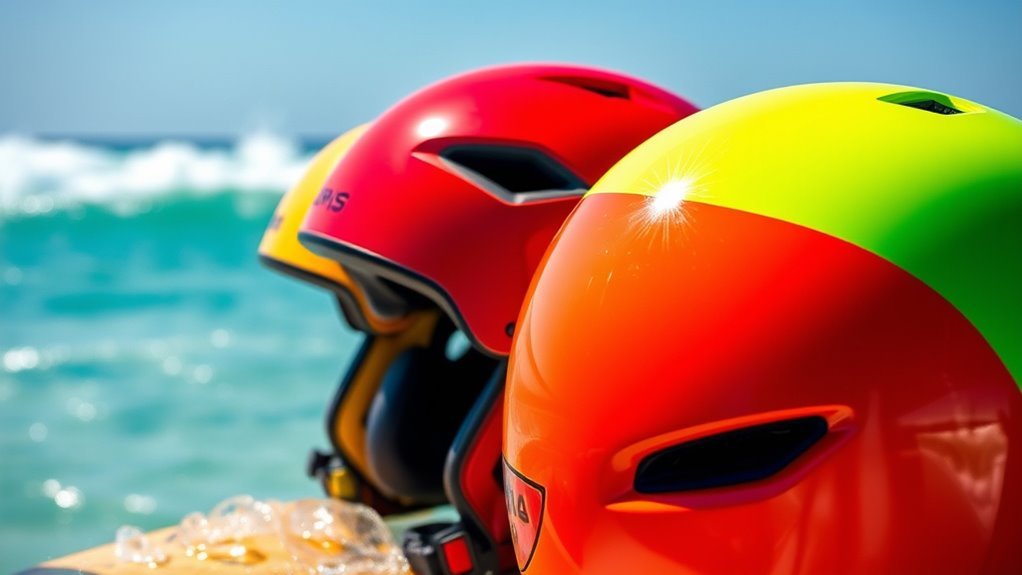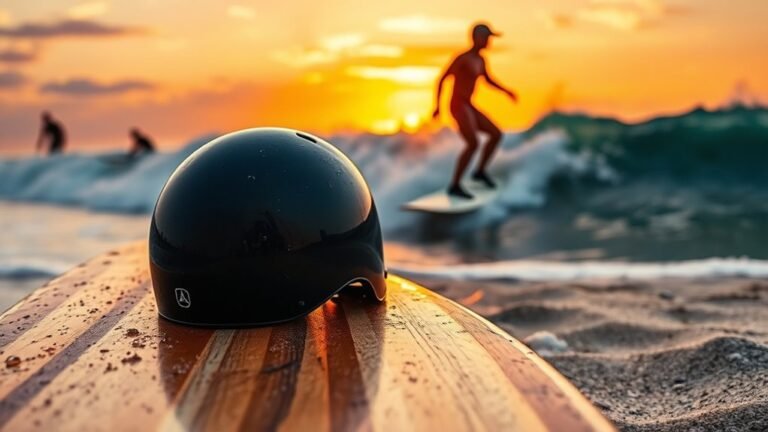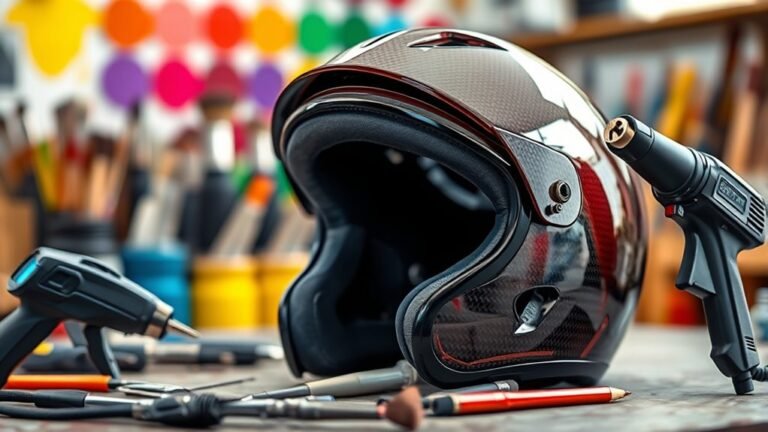Helmets for Windsurfing and Kiteboarding
When it comes to windsurfing and kiteboarding, wearing a helmet is essential for safeguarding your head from potential injuries. You’ll find various types, such as hard-shell for durability and soft-shell for comfort. Look for lightweight materials, proper fit, and safety certifications. A well-fitted helmet enhances your confidence while enjoying the thrill of the sport. By prioritizing safety, you can focus on the waves, and there’s plenty more to discover about choosing and caring for your helmet.
The Importance of Wearing a Helmet
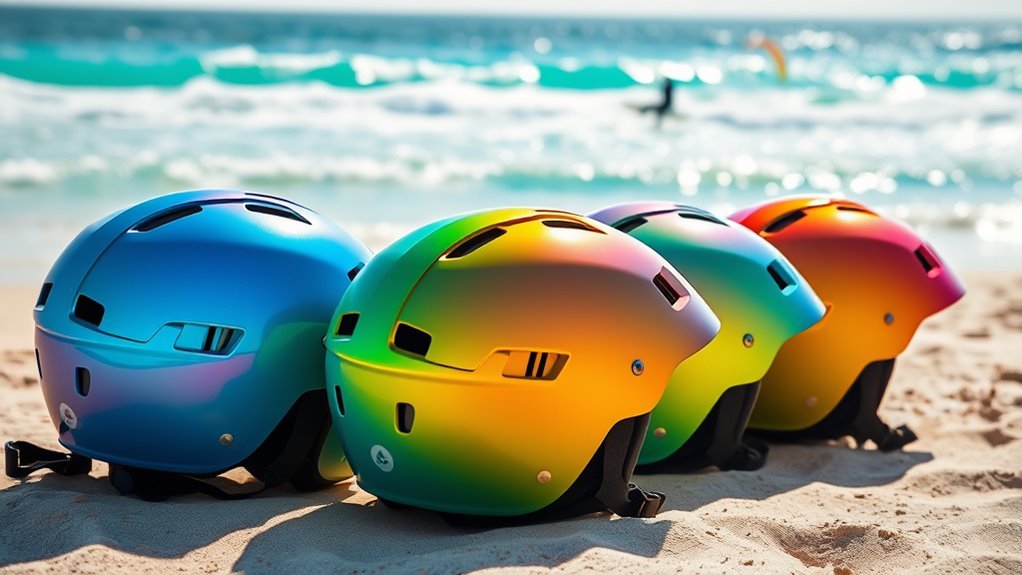
When you’re out on the water, whether windsurfing or kiteboarding, wearing a helmet isn’t just a precaution—it’s an essential safety measure. Safety statistics reveal that head injuries account for a significant percentage of water sports accidents. By wearing a helmet, you’re investing in impact protection that can prevent serious injuries from unexpected falls, collisions, or equipment mishaps. The freedom you crave while riding the waves comes with inherent risks, and a helmet helps reduce those dangers. It’s lightweight, designed for comfort, and guarantees that you can fully immerse yourself in the thrill of the sport without compromising your safety. Ultimately, prioritizing your protection allows you to enjoy every exhilarating moment with confidence.
Types of Helmets for Windsurfing and Kiteboarding
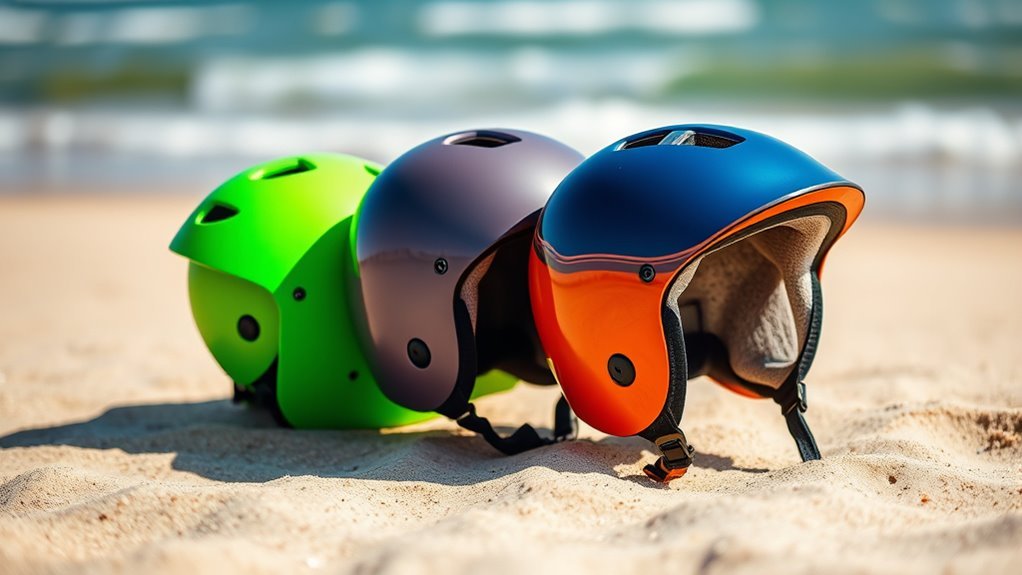
Choosing the right helmet for windsurfing and kiteboarding is essential for your safety and performance on the water. You’ll find various types of helmets designed specifically for these thrilling sports. First, consider hard-shell helmets, which offer excellent impact resistance, made from durable materials like ABS or polycarbonate. Then there are soft-shell helmets, typically constructed from lightweight foam, providing comfort and flexibility while still offering decent protection. Some helmets feature a combination of both materials, balancing weight and safety. Additionally, you’ll encounter helmets with removable visors and ear protection, catering to your individual preferences. Ultimately, selecting a helmet that fits well and aligns with your riding style makes all the difference in enjoying your time on the water.
Key Features to Look for in a Helmet
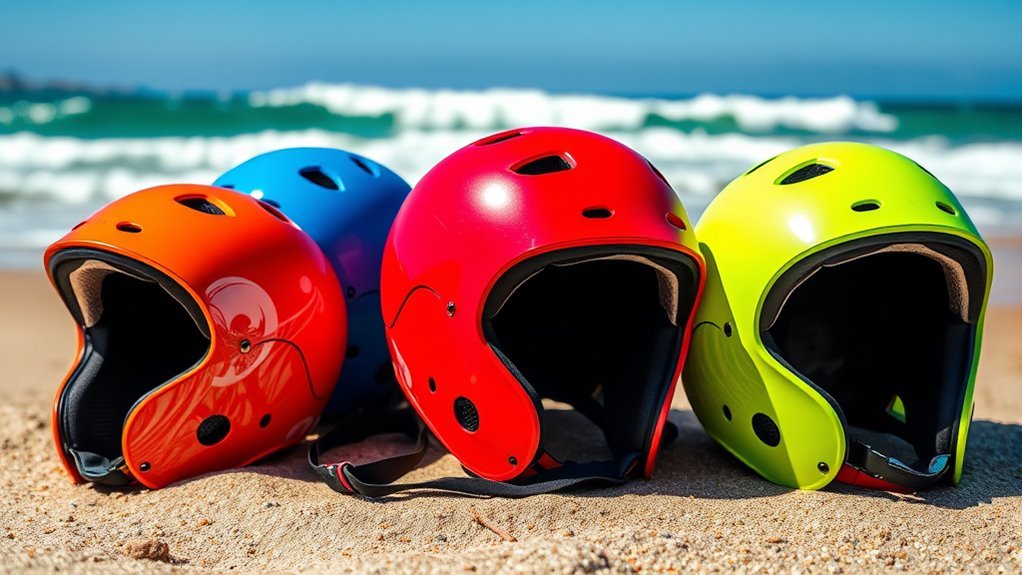
While you may be keen to hit the water, guaranteeing your helmet has the right features is essential for both safety and comfort. First, check the helmet materials; lightweight, durable options like polycarbonate or fiberglass offer great protection without sacrificing comfort. Look for helmets that meet recognized safety standards, such as ASTM or CE certifications, to guarantee reliable impact resistance. Ventilation is another key feature; adequate airflow keeps you cool during intense sessions. An adjustable fit system enhances security, preventing any movement during rides. Ultimately, consider a removable liner for easy cleaning, guaranteeing your helmet stays fresh. With these features in mind, you can confidently embrace the freedom of windsurfing and kiteboarding, knowing you’re well-protected.
How to Choose the Right Helmet for Your Needs
How can you guarantee you’re selecting the right helmet for your windsurfing or kiteboarding adventures? Start by considering helmet sizing; a snug fit is essential for safety. Measure your head circumference and consult sizing charts to find your perfect match.
Next, think about helmet materials. Look for lightweight, durable options like ABS or fiberglass that can withstand the rigors of your sport.
Here’s a quick comparison to help you decide:
| Material | Weight | Durability |
|---|---|---|
| ABS | Medium | High |
| Fiberglass | Light | Higher |
| Polycarbonate | Light | Medium |
Choosing wisely will enhance your experience on the water, giving you the freedom you crave without compromising safety.
Maintenance and Care for Your Helmet
Once you’ve selected the right helmet, keeping it in top condition is essential for your safety on the water. Regular maintenance guarantees your helmet performs well and lasts longer. Here are three key tips for helmet care:
- Helmet Cleaning: Rinse your helmet with fresh water after each session to remove salt, sand, and debris. Use mild soap and a soft cloth for deeper cleaning, avoiding harsh chemicals.
- Inspect Regularly: Check for cracks, dents, or any signs of wear. A damaged helmet can compromise your safety.
- Helmet Storage: Store your helmet in a cool, dry place away from direct sunlight. Use a helmet bag to protect it from scratches and impacts when not in use.
Frequently Asked Questions
Can I Use a Bicycle Helmet for Windsurfing or Kiteboarding?
You shouldn’t use a bicycle helmet for windsurfing or kiteboarding. These activities demand helmets that meet specific safety standards, designed to withstand higher impact forces and water conditions. Bicycle helmets typically use lighter materials that aren’t as durable in harsh environments. You’ll want a helmet made from robust materials that can protect you effectively during falls or impacts. Prioritize your safety and choose the right helmet for your thrilling adventures on the water.
How Do I Know if My Helmet Fits Properly?
When it comes to finding the right fit for your helmet, think of it like a knight choosing their armor; it needs to protect you without restricting your freedom. Start with a fit assessment by measuring your head and consulting the sizing guidelines. The helmet should sit snugly on your head, without wobbling, and the padding should feel comfortable. Remember, a proper fit guarantees you stay safe while enjoying your adventures!
Are There Any Age Restrictions for Wearing Helmets?
There aren’t universal age restrictions for wearing helmets, but helmet safety guidelines often suggest that children and teens should always wear them during activities. It’s essential to check the specific age guidelines provided by helmet manufacturers or local regulations. Regardless of age, wearing a helmet is a smart choice that enhances safety and encourages freedom on the water. Prioritizing protection allows you to enjoy your activities with greater peace of mind.
What Is the Average Lifespan of a Windsurfing Helmet?
The average lifespan of a windsurfing helmet is about 3 to 5 years, depending on usage and care. Helmets made from advanced materials like polycarbonate or fiberglass offer excellent impact resistance, but they can degrade over time due to exposure to UV rays and saltwater. If you’re serious about safety, it’s essential to regularly inspect your helmet for any signs of wear and consider replacing it after significant impacts, even if it looks fine.
Can Wearing a Helmet Affect My Performance in the Water?
Wearing a helmet can actually enhance your performance in the water. While some might think it hinders mobility, the benefits often outweigh any perceived drawbacks. A helmet provides essential protection, giving you the confidence to push your limits, which can lead to improved skills. Plus, knowing you’re safeguarded from potential injuries can reduce anxiety, allowing you to focus on technique and flow, ultimately boosting your performance impact in dynamic conditions.
